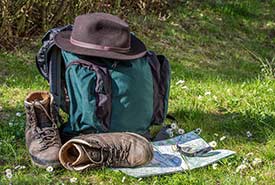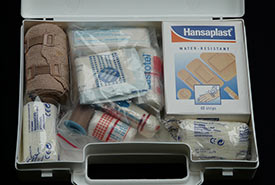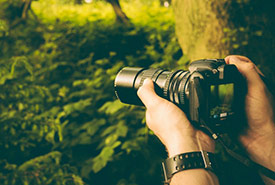Top 10 backpack essentials for any nature lover

Hiking gear (CC0 Public Domain)
Nature enthusiasts know there is nothing better than experiencing all of the sights, sounds and smells that nature has to offer. With an abundant variety of beautiful landscapes in Canada, it’s no wonder the great outdoors call to us.
Whether you’re a budding naturalist or a seasoned pro, it’s important to be prepared. Packing wisely not only increases your enjoyment, it helps make your excursion safe and comfortable.
Being prepared means being able to deal with unexpected circumstances that you might find yourself faced with, such as weather changes or injuries. Packing smart is important for all excursions, regardless of length.
So to get your backpack ready, check out these top 10 items to bring on your next adventure!
1. Water
It’s very important to stay hydrated, especially in warm weather when you can become easily dehydrated. The amount of water you carry depends on the length of your excursion, and the weather conditions. You may want to carry extra water as well, especially in cases of extreme temperature conditions, where you’ll need to replace the fluid you lose to perspiration.
You can also consider bringing a water filter/pump. This is a great way to take advantage of water sources, such as streams, while ensuring the drinking water will be clean.
2. Food

Nuts make a great lightweight snack. (CC0 Public Domain)
It goes without saying that nutrition for any nature adventure is essential. You’ll most likely use lots of energy, and you’ll need to refuel to keep up your calories. No one wants to be hangry (a combination of hungry and angry) when out exploring nature. So refuel yourself with lightweight, high-energy snacks, such as granola bars, dried fruit, nuts, bagels, etc. The amount of food you pack is dependent on your trip length and your own personal requirements. Pack additional food, as necessary. Nothing beats enjoying a good snack while you take in stunning views.
3. Sun protection
It’s easy to get sunburned during long summer days. While applying sunscreen is a good place to start, further protect yourself with sunglasses, a hat, long-sleeved clothes and lip balm with SPF.
Fun fact: Lips can easily burn. They do not contain melanin (pigment), which protects us against sun damage.
4. Navigation tools
The last thing you want to do is get lost on your excursion. Bring a map (topographical maps work best) and a compass. Additionally, a GPS unit, such as InReach, may be handy to carry as well. Before heading out, make sure you know how to use these tools.
5. First aid kit

First aid kit (CC0 Public Domain)
You’ll definitely want a first aid kit with you in case of injury. Make sure all of the items in your kit are well-stocked, that nothing has expired and you know how to properly use everything in it.
6. Multi-use tool
Multi-purpose tools, such as a pocketknife, have many uses. From repairing gear, to first aid, to slicing up cheese at the snack stop, a multi-purpose tool is definitely handy.
7. Insect repellent

Adult deer tick (Photo by Scott Bauer/Wikimedia Commons)
Depending on the time of year, there will come a point where you'll likely have had enough with the mosquitoes and other biting insects as you try to dance your way around them. Pack some insect repellent to save yourself from the annoyance — and itch — of bites and stings.
Remember to watch out for ticks when you’re outdoors as they can pose a health risk and transmit Lyme disease. Check out the Nature Conservancy of Canada’s (NCC's) tips for tick safety!
8. Communication device
Bring a charged cell phone with you. You can enclose it in a Ziploc bag to avoid getting it wet. If you’re not using your phone, turn it off so you don’t waste the battery. Another important thing to bring is a whistle; if you get lost, it’s more effective than screaming.
9. Extra layers
Weather conditions can change in the blink of an eye. Dress in layers, and carry extra clothing in anticipation of weather changes.
10. Camera

Photographing nature (CC0 Public Domain)
Lastly, don't forget your camera. You’ll definitely want to capture the beauty of nature and any species you may see. A picture is indeed worth a thousand words.
Remember that for any outdoor adventure, you should always let someone know where you’re going ahead of time.
This summer, explore the great outdoors. Through NCC’s Nature Destinations program, journey through some of our country’s greatest natural areas and connect with nature.
Check out the cold-weather outdoor essentials of renowned filmmaker and survival specialist Les Stroud here.
The Conservation Internship Program is funded in part by the Government of Canada’s Summer Work Experience program.


